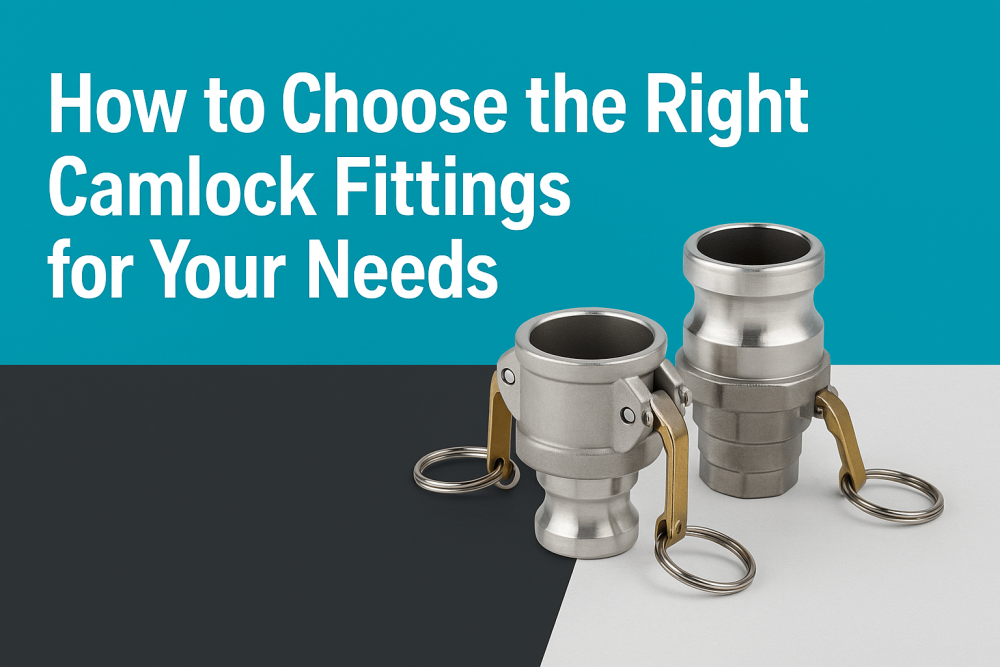When it comes to effective and secure transfer of liquids, powders, or gases, camlock fittings are one of the most reliable choices. These are quick-connect couplings that are widely utilized in various industrial applications across industries like agriculture, chemicals, oil & gas, food processing, and construction because they allow hose connections to be made fast, securely, and leak-free.
But here’s the rub: with so many configurations, materials, and sizes to select from, how do you select the correct camlock fitting for your application? Making a mistake will result in leaks, lost efficiency, safety risks, and costly downtime. This guide takes the mystery out of all you need to know to do it correctly.
What Are Camlock Hose Fittings?
Camlock hose fittings are tool-less quick-connect couplings that let pipes and hoses be connected without a wrench. Rather than threading or clamping, the fittings employ cam arms that click into position, making a secure seal within seconds.
Due to their universality, camlock hose couplers find application in various industries—be it transferring water in agriculture, fuel in oil & gas, or powders in food processing. Their universal design allows them to fit in various applications, thus they’re commonly referred to as the “industry standard” of fluid transfer.
Types of Camlock Fittings
Not all camlock fittings are created equal. Each type is made for particular hose-to-hose or hose-to-equipment connections:
- Type A: Male adapter × female threaded coupler
- Type B: Female coupler × male threaded adapter
- Type C: Female coupler × hose tail adapter
- Type D: Female coupler × female threaded adapter
- Type E: Male adapter × hose tail adapter
- Type F: Male adapter × male threaded adapter
- Dust Caps/Plugs: Guard unused hose ends
Tip: For quick hose-to-hose couplings in agriculture, Types C and E are favored. Types A, B, and F are more frequently used for industrial pipes.
Materials Used in Camlock Hose Connectors
The material of your camlock coupling can make or break its performance:
- Aluminum: Low weight, inexpensive, great for water and petroleum products.
- Stainless Steel: Resistant to corrosion, robust, great for chemicals, oils, and food-grade applications.
- Brass: Long-lasting and spark-resistant, commonly used for petroleum and chemical use.
- Polypropylene (Plastic): Lightweight, affordable, great for water and mild chemicals.
- Nylon: More robust than polypropylene, resistant to some chemicals and abrasion.
- Rule of thumb: Always pair the fitting material with the transferred fluid so as not to cause chemical reactions or premature wear.
Factors to Consider When Choosing Camlock Hose Fittings
In selecting the appropriate camlock fitting, remember these factors:
Application & Industry Needs
- Food & Beverage → Stainless steel (hygienic, corrosion-resistant)
- Agriculture → Aluminum or polypropylene (lightweight, affordable)
- Chemicals → Stainless steel or nylon (resistant to harsh substances)
Size & Pressure Rating
Make sure the camlock coupling is equal to the hose diameter.
Verify pressure ratings (PSI) to safely manage the system’s requirements.
Temperature Range
Stainless steel responds to high heat more effectively than plastic fittings.
Polypropylene and nylon can deteriorate at elevated temperatures.
Safety & Ease of Use
Quick connect/disconnect saves time.
Seek camlock hose connectors with reinforced gaskets to eliminate leaks.
Balancing these factors will make sure your camlock fitting operates safely and efficiently within your system.
Common Mistakes to Avoid
Most users receive the inappropriate camlock fitting due to minor oversights. Steer clear of these errors:
Selecting fittings made of the inappropriate material for your fluid.
Not considering hose size and pressure demands.
Combining incompatible couplings (different standards).
Overlooking to replace worn-out seals and gaskets.
Benefits of the Right Camlock Hose Coupling
When you use the correct camlock hose coupling, you will realize instant advantages:
Safety: Spills- and accident-free connections.
Efficiency: Time-saving quick-connect design improves productivity in high-speed industries.
Durability: Carefully matched fittings endure longer and need less replacement.
Cost Savings: Reduced downtime, fewer leaks, and extended equipment life.
Maintenance Tips for Camlock Hose Fittings
To maximize the lifetime of your camlock connectors:
Clean the fittings after each use, particularly in chemical or food service applications.
Check frequently for signs of wear, cracks, or corrosion.
Replace seals and gaskets to ensure a tight seal.
Store in a dust-free, dry condition to avoid damage.
Final Thoughts
Camlock hose fittings are one of the best practical, versatile, and long-lasting hose connection solutions—but only if you select the right one. By taking material, size, pressure rating, and application into account, you can make sure your camlock hose connectors provide maximum performance and safety.
Whether you’re in agriculture, manufacturing, or oil & gas, investing in the right camlock hose coupling from Proflow Dynamics means fewer leaks, better efficiency, and long-term reliability.
